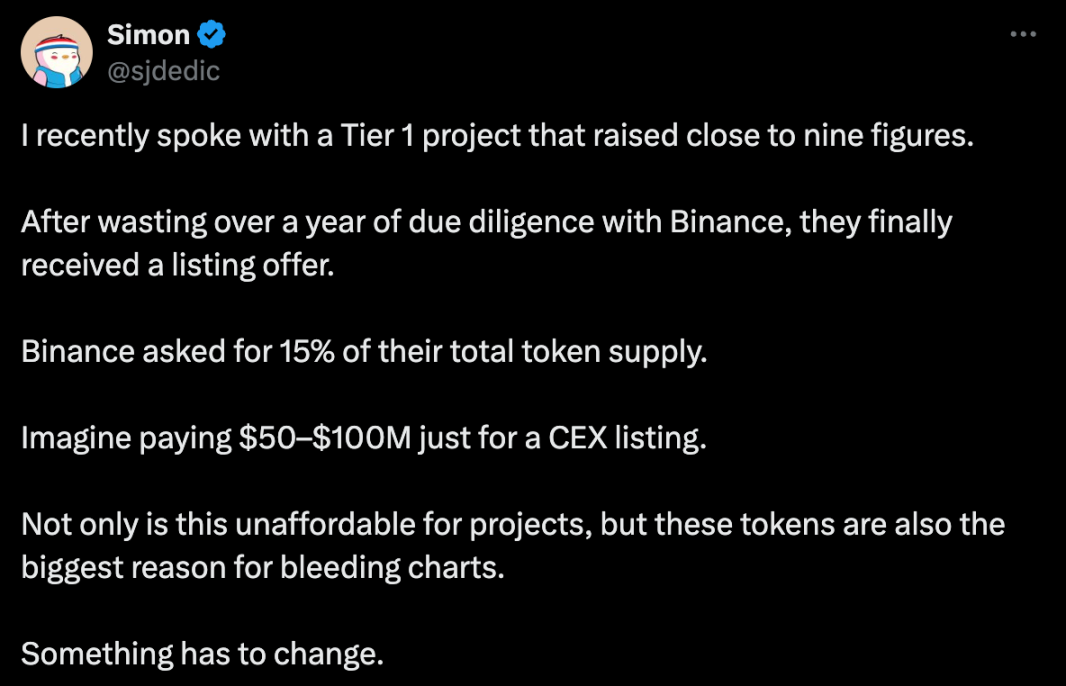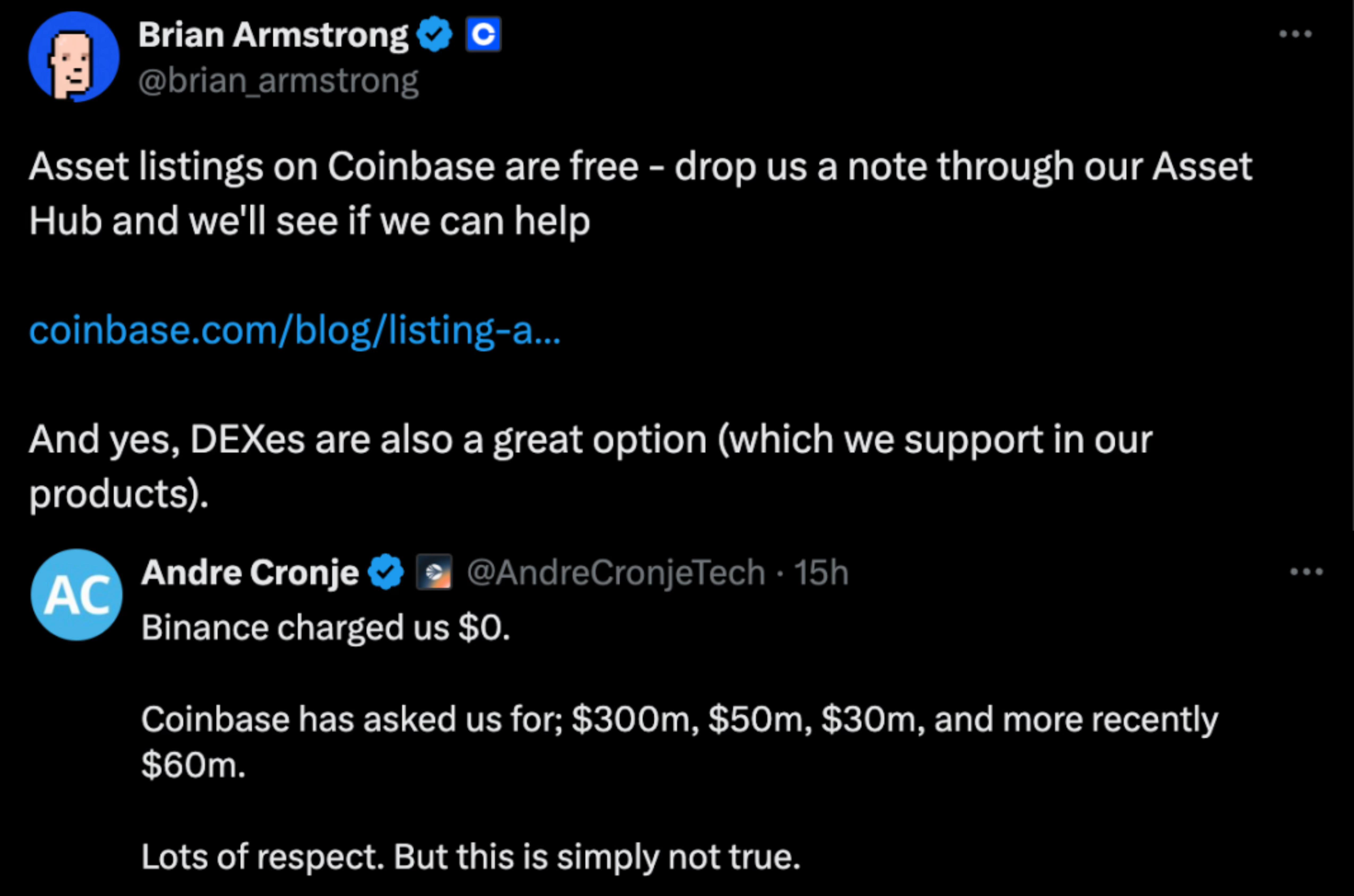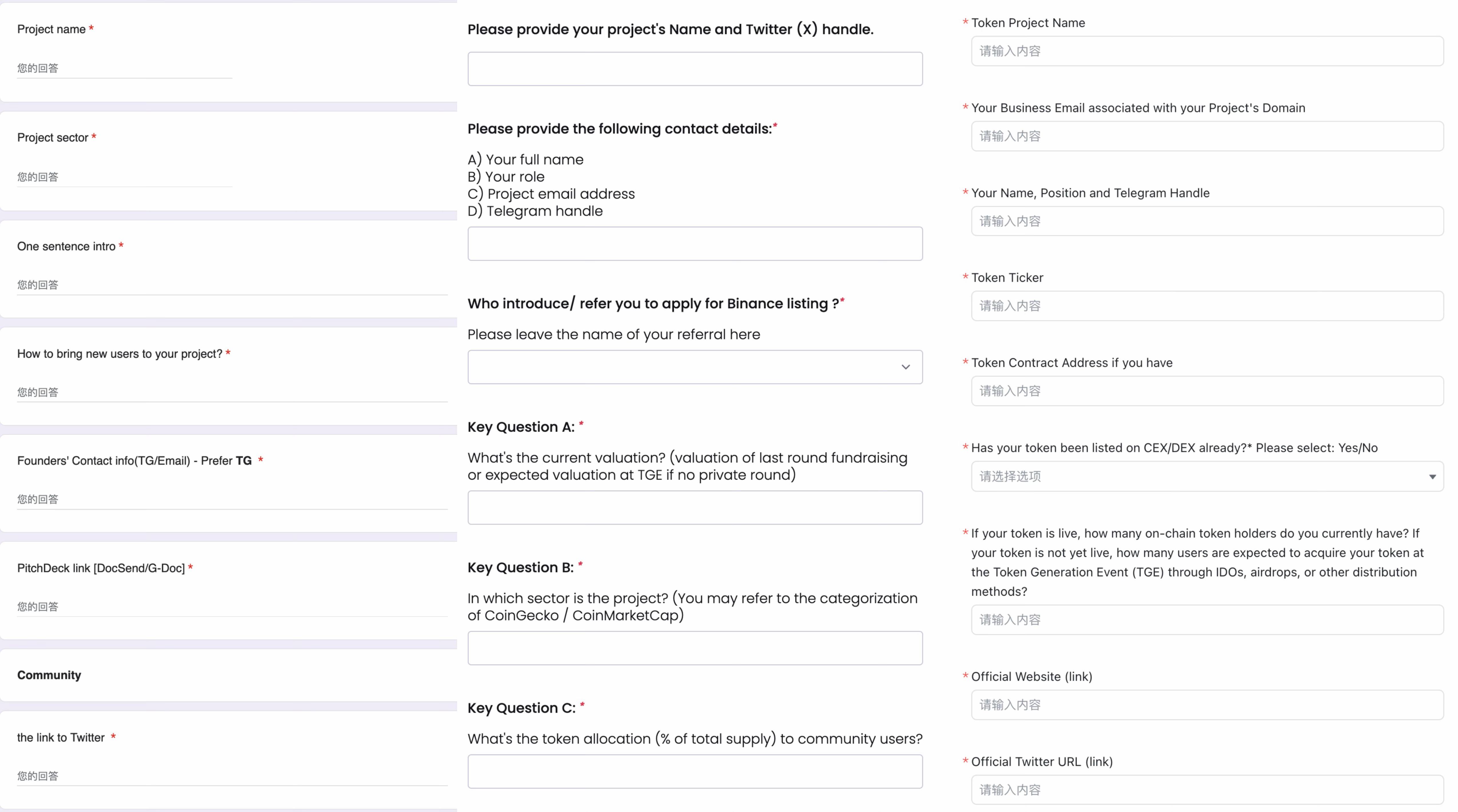Written by: Iris, Liu Honglin, Mankiw LLP
Which Web3 project doesn’t issue coins? But how to issue them? Which virtual asset exchange to issue them on? This is a question that Web3 project owners should consider. In many cases, Web3 project owners often choose to list their coins on the top crypto exchanges. The reason is:
In the eyes of users, being listed on such exchanges = the exchange affirms the value of the project = the coin will definitely increase in value = buy it!
In the eyes of project owners, listing coins on top exchanges = user buy-in + exchange support = getting rich quickly.
This brings us to another issue: listing fees . Considering that in recent years, even if a project is listed on a top exchange, the market performance may not necessarily pick up, so many Web3 projects have to consider the cost-effectiveness when listing a coin - is the listing fee appropriate? In addition, I paid a high fee. In addition to listing a coin on your platform, is there any other "support" that can guarantee my income?
This week, a new round of "war" has begun over coin listing fees. In this article, let attorney Mankiw take everyone through the details.
Sky-high listing fees
Although many crypto exchanges do not disclose the listing fees openly, and usually only have an entry and contact information for listing applications, the potential cost of "listing fees" has long been circulated in the market. However, this time, the head-on "hard fight" between Binance and Coinbase has made the topic of listing fees full of fire, and many KOLs in the cryptocurrency circle have also participated in the discussion.

The incident started on November 1st, when the CEO of Moonrock Capital, a cryptocurrency consulting and investment company, broke the news on Twitter, saying that Binance had proposed a listing condition of "15% of tokens" to a certain leading project party - equivalent to 50 million to 100 million US dollars based on the market value. This news instantly caused an uproar in the market, and rumors about Binance's "sky-high listing fees" quickly fermented, and KOLs also took sides. Some people believe that this "sky-high listing fee" comes from the huge power of the leading exchanges, while others believe that the listing model of centralized exchanges is damaging the long-term interests of project parties, users and the market, and even sparked discussions on the necessity of decentralized exchanges (DEX).
Originally, the center of the debate was Binance, but a tweet from Coinbase co-founder Brian Armstrong dragged the top exchange into the fray. Armstrong said that "Coinbase's listing is free," but before he finished speaking, Sonic Labs co-founder Andre Cronje jumped out to reveal that Binance did not charge them for listing, but Coinbase asked for a fee, even up to tens of millions. Instantly, the debate escalated from "whether the top exchanges charge sky-high listing fees" to "who is charging and who charges more."

However, some people questioned whether Andre Cronje had met a fake Coinbase staff, but Andre Cronje said that all communication records could be made public. During this period, He Yi of Binance also tweeted that there was no listing fee. If you have any questions, you can refer to the tokens that have been launched. Binance has set up a token distribution introduction, and you can see whether it has charged 15% at a glance.
So far, there is no definitive answer to the question of whether there is a listing fee. However, the battle over the listing fee has also made people reflect on what role virtual currency exchanges play in the crypto industry. What kind of support does the listing service provided by the exchange include? Will this support affect the market price trend, or even affect the rights and interests of ordinary users? Attorney Mankiw believes that the hidden impact of these behind-the-scenes operations is a more worthy issue of concern.
Exchange listing application
In order to gain a deeper understanding of the current listing process of virtual currency exchanges, Attorney Mankiw attempted to perform basic application operations on several well-known trading platforms such as Binance, Coinbase, and OKX.

*Screenshots of some platform application pages
In the initial application stage, Web3 project parties can only fill out the application form to submit basic information about the project and tokens for review by the platform. As many people on the Internet have criticized, the information is completely opaque . At this stage, applicants usually have difficulty in obtaining specific details such as the listing services and fees. They can only "leave everything to fate" and wait for contact from the listing support team. Usually, the project party is likely to be asked to sign a confidentiality agreement in the early stages of communication with the platform, prohibiting the disclosure of specific information and communication records related to the listing (this is also the reason why Andre Cronje said in his response that the information could be made public, and he did not sign the relevant confidentiality clause).
Although all listing information is kept confidential, there is no such thing as an impenetrable wall. Based on the communication between Mankiw’s legal team and industry insiders, combined with a number of relevant articles on the Internet, we can basically piece together the “three tricks” of the current mainstream exchanges’ listing fees and corresponding services:
Technology Fees and Integration Support
The technical fee is a basic fee charged by the platform, usually settled in stablecoins . This fee is mainly used by the platform's technical team to adapt and integrate project tokens, including token contract review, compatibility testing and technical support. The technical fees of different exchanges vary to a certain extent, mainly depending on the integration complexity of the platform and the required security standards.
Marketing expenses and promotion
How to get traffic after listing a coin? This is a headache for many project parties, and the marketing services of exchanges can partially solve this demand. The marketing services of exchanges usually include media publicity, airdrops, liquidity mining, user incentive activities, etc. For this reason, exchanges often require project parties to provide a certain amount of tokens as promotion rewards. Such airdrop activities have a good effect in increasing project exposure and attracting new users, but Web3 project parties also need to consider whether such "airdrops" will bring too much selling pressure.
Margin
Margin is another important fee, which is usually paid in stablecoins . Exchanges often require project parties to deposit a certain amount of margin to ensure that the token price does not fluctuate significantly. This means that if the market performance of the token is poor after listing and the price falls below a certain standard, the exchange may not refund the margin as a "bottom line" to compensate for the loss of platform liquidity. This fee is a considerable burden for the project party, but in the view of the exchange, such a margin mechanism can not only protect the platform image, but also screen out more stable projects.
In addition, some exchanges also provide market-making services for Web3 projects. Although market-making services are usually not standard services for listing coins, many projects will use them as an additional means to improve token liquidity and market performance.
In general, Web3 projects may not have the "currency listing fee" that most people think of when listing on exchanges, but other links still involve fees. These links have their own functions, and at least on the surface, these currency listing services seem to be aimed at ensuring the security and liquidity of Web3 projects on the platform and attracting more users.
Potential risks of coin listing services
However, Mankiw believes that there may be some potential risks behind these service combinations that cannot be ignored - once the exchange and the project party reach a tacit understanding on interests, the listing of coins may become a place for "joint market making". So, how do these "services" affect the fairness of the market? Here, Mankiw now raises some questions of his own:
1. Promotional marketing: Will it create the illusion of short-term traffic?
Marketing fees after listing are often used for user incentive activities such as airdrops and liquidity mining. Undoubtedly, such mechanisms can quickly increase the circulation and trading volume of tokens in the short term, bringing high attention to the project. But we have to consider a question: Is this initial traffic a long-term support or a short-term "false fire"?
If such high incentives are used in the early stage of listing, it is likely to quickly push up the token price, triggering the psychology of ordinary users to chase the rise, thus creating a "good" market performance in the short term. However, once the airdrop rewards of the token are exhausted, the liquidity may drop significantly, and the market price will be under pressure. In this case, the investment risk of ordinary users will increase significantly.
2. Margin: Protecting the market or a hidden “minefield of risk”?
In the process of listing coins on exchanges, margin is often seen as a "protective umbrella" for the market. Project parties generally need to pay a certain amount of margin to ensure that the token price remains relatively stable in the early stage and prevent a sharp drop due to insufficient liquidity or market fluctuations. On the surface, margin provides short-term support for tokens and creates a "stable" image, which undoubtedly attracts more investors to enter the market, especially those retail investors who are confident in short-term stability.
However, the effect of margin support is not lasting. Once the project party or exchange stops the support operation, or the margin funds are exhausted, the token price may lose support instantly. For retail investors, this "support" creates the illusion of price stability in the early stage, making it easy for them to enter at high prices. Once the support is withdrawn and the price support disappears, the assets of retail investors may shrink rapidly and the risk will suddenly increase. This situation not only poses potential risks to ordinary investors, but may also exacerbate market volatility and bring about wider panic.
3. Market making: to “add fuel” to liquidity or to “control” prices?
On the surface, market making services provide liquidity support for project parties and help tokens remain smooth on exchanges. However, if the worst-case scenario occurs, that is, exchanges and project parties work together to influence market sentiment by adjusting trading volume and controlling liquidity, market making services may become a hidden means of price manipulation. Many market makers have also been criticized by regulators and the market for such doubts.
For retail investors, the rapid growth of trading volume often means a bullish signal in the market, prompting them to enter the market at a high level. However, the reality is that trading volume may not be driven by real demand, but rather an illusion of liquidity "created" by market-making services. This manipulation may ultimately cause retail investors to be trapped at high prices and bear higher risks, while exchanges and project parties reap liquidity benefits behind the scenes.
Behind seemingly normal trading fluctuations in the market may be the elaborate arrangements of market-making services, especially when retail investors lack sufficient information transparency. This "mild" price guidance is not only unfair to retail investors, but may also call into question the authenticity of the market and attract the attention of regulators.
Attorney Mankiw recommends
In summary, although the coin listing service is an auxiliary tool to help projects go online smoothly, in the absence of transparency and supervision, exchanges and project parties may reach a tacit understanding to influence market price trends through market-making services, margin and marketing activities, and even mislead retail investors. Therefore, Mankiw recommends:
As for Web3 project owners, they should be cautious in the listing process when choosing an exchange, and give priority to platforms with high transparency and clear service projects. At the same time, project owners must strictly follow the principle of information disclosure and avoid promotional activities that may mislead investors in order to maintain their brand reputation.
As far as virtual currency exchanges are concerned, transparency in the listing process, disclosure of fees, and strengthening of external supervision will not only help enhance market fairness, but also effectively protect the rights and interests of ordinary investors. Exchanges should establish a sound disclosure mechanism and clarify the content and fee standards of various listing services to reduce negative market speculation. At the same time, introduce compliant external audits or regulatory agencies to ensure that trading behaviors comply with market rules and enhance the overall trust of the industry.
As for individual investors, before investing in tokens, investors must carefully analyze the fundamentals of the project to avoid being confused by short-term market fluctuations and high-frequency airdrop activities. For newly launched tokens with large price fluctuations, investors are advised to remain rational and patient and not blindly chase the rise to avoid potential risks. At the same time, investors should pay attention to the market activities of related projects and the transparency of exchanges, so as to make more rational investment decisions.
Through these multi-level recommendations, Attorney Mankiw hopes to further promote the transparency and compliance of the virtual asset market, maintain the long-term healthy development of the market, and provide solid support for the innovative ecosystem of Web3.












